CDS Book and Working Papers Being Released by the Honorable Vice Chancellor of Rajiv Gandhi University on 17th December, 2020.
First Human Development Report of Arunachal Pradesh
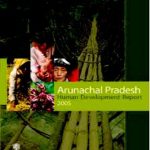 The Department of Economics has the distinction of acting as a nodal Department for the preparation of the First Human Development Report (HDR)of Arunachal Pradesh. The HDR project was coordinated by Prof. N.C. Roy and the other faculty members of the Department were actively engaged in the preparation of this report. It was a report which was based on primary survey conducted in around 5,257 households with 30,762 individuals covering all the districts of the State. It was sponsored by the UNDP and Planning Commission, Government of India, New Delhi. The final report was released in October 2006. The Report was one of its own kind and hence was much appreciated in the academic circles across the country.
The Department of Economics has the distinction of acting as a nodal Department for the preparation of the First Human Development Report (HDR)of Arunachal Pradesh. The HDR project was coordinated by Prof. N.C. Roy and the other faculty members of the Department were actively engaged in the preparation of this report. It was a report which was based on primary survey conducted in around 5,257 households with 30,762 individuals covering all the districts of the State. It was sponsored by the UNDP and Planning Commission, Government of India, New Delhi. The final report was released in October 2006. The Report was one of its own kind and hence was much appreciated in the academic circles across the country.
First State Development Report of Arunachal Pradesh
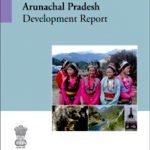 The Department also has the distinction of preparing the First Arunachal Pradesh Development Report. The SDR project was coordinated by Prof. S.K. Nayak and with Prof. Atul Sarma, the then Vice Chancellor heading the Research Team. The faculty members of the Department were actively engaged in the preparation of SDR which was sponsored by the Planning Commission, Government of India, New Delhi. The final report was released by Deputy Chairman of the Planning Commission in December 2009. The Department has recently completed a study on ‘Evaluation of State Finances in Arunachal Pradesh, sponsored by the Fourteenth Finance Commission.
The Department also has the distinction of preparing the First Arunachal Pradesh Development Report. The SDR project was coordinated by Prof. S.K. Nayak and with Prof. Atul Sarma, the then Vice Chancellor heading the Research Team. The faculty members of the Department were actively engaged in the preparation of SDR which was sponsored by the Planning Commission, Government of India, New Delhi. The final report was released by Deputy Chairman of the Planning Commission in December 2009. The Department has recently completed a study on ‘Evaluation of State Finances in Arunachal Pradesh, sponsored by the Fourteenth Finance Commission.
Prof. S. K. Nayak, Dr.LijumNochi and Dr.Maila Lama: (2019) (Edited)
Hill Economics and Sustainable Development in India: Emerging Realities, Concept publishing Company Pvt. Ltd, New Delhi
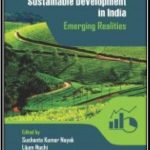 The book deals with issues and challenges of sustainable development in hill economies of India. It analyses the comparative advantages and challenges of the hill regions of India which comprises of 11 States.
The book deals with issues and challenges of sustainable development in hill economies of India. It analyses the comparative advantages and challenges of the hill regions of India which comprises of 11 States.
The papers in the book have attempted to address a wide range of issues such as livelihood diversification, food security, agricultural sustainability, poverty, inequality, urbanisation, migration, fiscal governance etc. Ajit Debnath and Amitava Mitra (2019); Growing Urbanization and Challenges of Solid Waste Management in Eastern Himalayas. Blue Rose, New Delhi
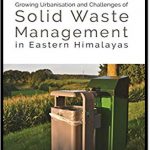 This book has taken into account an in-depth analysis of urbanization, solid waste accumulation and management as well as household willingness to pay for improved solid waste management in selected towns of a state in the Eastern Himalayas, i.e., Arunachal Pradesh. The volume of municipal solid waste is increasing day by day because of increasing population, urbanisation, developmental activities, and changes in lifestyle, food habits and socio-economic activities etc., although collection efficiency and infrastructure are not growing adequately. Considering the advent of the Swachh Bharat Abhiyan Policy in India, this book can be an important document for academicians, environmentalists, environmental economists, professionals, social scientists, researchers, policy makers, planners, administrators, civic community and the general public concerned about urban environmental problems
This book has taken into account an in-depth analysis of urbanization, solid waste accumulation and management as well as household willingness to pay for improved solid waste management in selected towns of a state in the Eastern Himalayas, i.e., Arunachal Pradesh. The volume of municipal solid waste is increasing day by day because of increasing population, urbanisation, developmental activities, and changes in lifestyle, food habits and socio-economic activities etc., although collection efficiency and infrastructure are not growing adequately. Considering the advent of the Swachh Bharat Abhiyan Policy in India, this book can be an important document for academicians, environmentalists, environmental economists, professionals, social scientists, researchers, policy makers, planners, administrators, civic community and the general public concerned about urban environmental problems
Deepak K Mishra and Vandana Upadhyay (2017) Rethinking Economic Development in North East India: The Emerging Dynamics (Edited) Routledge, London and New Delhi
Economic development of frontier and remote regions has long been a central theme of development studies. This book examines the development experience in the northeastern region in India in relation to the processes of globalisation and liberalisation of the economy. Bringing together researchers and scholars, from both within and outside the region, the volume offers a comprehensive and updated analysis of governance and development issues in relation to the northeastern economy. With its multidisciplinary approaches, the chapters cover a variety of sectors and concerns such as land, agriculture, industry, infrastructure, finance, human development, human security, trade and policy.
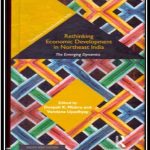
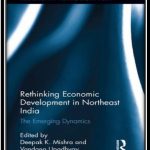
Deepak K Mishra, Vandana Upadhyay and Atul Sarma (2013) : The Unfolding Crisis in Assam’s Tea Plantations: Employment and Occupational Mobility, Routledge, London and New Delhi
 As the Indian economy integrates into global circuits of production, exchange and accumulation, the burdens of adjustment are shared unequally by different sectors, classes and regions. This study unravels the livelihood strategies and living conditions of labour in Assam’s tea sector, which has been undergoing a crisis since the 1990s. Stagnant production, decline in exports, and closures of many tea gardens have led to large-scale retrenchments in the labour force. The study begins by contextualising the Assam tea sector in a comparative and historical perspective and then delineates the chief employment characteristics of labour in this industry. Based on a detailed analysis of secondary data and primary field research, it goes on to examine the extent, types and implications of inter-generational occupational mobility (or immobility) among labourers in Assam’s tea gardens. In the process, it reflects on how even a sector that brought capital and labour from outside and contributed significantly to the country’s export earnings failed to create dynamic growth linkages within the local economy.
As the Indian economy integrates into global circuits of production, exchange and accumulation, the burdens of adjustment are shared unequally by different sectors, classes and regions. This study unravels the livelihood strategies and living conditions of labour in Assam’s tea sector, which has been undergoing a crisis since the 1990s. Stagnant production, decline in exports, and closures of many tea gardens have led to large-scale retrenchments in the labour force. The study begins by contextualising the Assam tea sector in a comparative and historical perspective and then delineates the chief employment characteristics of labour in this industry. Based on a detailed analysis of secondary data and primary field research, it goes on to examine the extent, types and implications of inter-generational occupational mobility (or immobility) among labourers in Assam’s tea gardens. In the process, it reflects on how even a sector that brought capital and labour from outside and contributed significantly to the country’s export earnings failed to create dynamic growth linkages within the local economy.
Vandana Upadhyay (2014): Work Participation and Time-Use Pattern of Women in Rural Arunachal Pradesh, VVGNLI, Noida, India
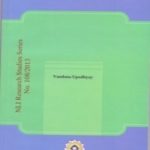 The book attempts to understand household work, workforce participation, and division of labour in rural Arunachal Pradesh. Using both qualitative and quantitative approach, the average time spent on household work and agricultural activities by both men and women and the gendered division of labour has been examined by the author through a time use survey. In case of Arunachal Pradesh, the time use survey has an added significance, given the relative importance of subsistence production and low levels of commercialisation of the economy. It is observed that the problems of underestimation of women’s work are found to be far more serious in the State. The book highlights that economic transformation of the State itself has generated gendered processes of exclusion and impoverishment. Although gender relations in Arunachal Pradesh is generally described as egalitarian, particularly in comparision with many other states of India, such a general portrayal, the paper has attempted to argue, not only hides the wide variations that exists among the north eastern states, but also does not pay adequate attention to the continuing and emerging disparities in various dimensions of well being, division of labour and empowerment.
The book attempts to understand household work, workforce participation, and division of labour in rural Arunachal Pradesh. Using both qualitative and quantitative approach, the average time spent on household work and agricultural activities by both men and women and the gendered division of labour has been examined by the author through a time use survey. In case of Arunachal Pradesh, the time use survey has an added significance, given the relative importance of subsistence production and low levels of commercialisation of the economy. It is observed that the problems of underestimation of women’s work are found to be far more serious in the State. The book highlights that economic transformation of the State itself has generated gendered processes of exclusion and impoverishment. Although gender relations in Arunachal Pradesh is generally described as egalitarian, particularly in comparision with many other states of India, such a general portrayal, the paper has attempted to argue, not only hides the wide variations that exists among the north eastern states, but also does not pay adequate attention to the continuing and emerging disparities in various dimensions of well being, division of labour and empowerment.
Working Papers of the Centre for Development Studies
Dr. Lijum Nochi: “Dynamics of Livelihoods along foothills of Arunachal Pradesh”.
Working Paper No. CDS/01/2019
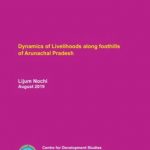 The Working paper focusses on the dynamics of Livelihoods along the foot hills of the State of Arunachal Pradesh. It deals with the various facets of livelihood activities and accesses. It ranges from occupational paradigm to land use pattern, from the household assets to farm practices, from dependence on natural resources to socio-institutional access. Based on the livelihood approach, the study has designed household livelihoods portfolio. It emphasis that the existing structures and processes do influence and shape the outcome of the livelihoods portfolio. The households in securing their livelihoods are faced with the problems of trading off and substitution of strategies and practices, giving rise to multiple least cost livelihood portfolios. In addition to farm activity, there are also set of allied farm activities in the portfolio of the households. The poor households are dependent upon nature-based livelihood activities such as fishing, hunting and trapping, in addition to gathering and extraction which constitutes an important part of their livelihoods portfolio. The study emphasises that the need of the hour is the right kind of interventions in the form of physical assets and technology at a lower cost for livelihood diversification.
The Working paper focusses on the dynamics of Livelihoods along the foot hills of the State of Arunachal Pradesh. It deals with the various facets of livelihood activities and accesses. It ranges from occupational paradigm to land use pattern, from the household assets to farm practices, from dependence on natural resources to socio-institutional access. Based on the livelihood approach, the study has designed household livelihoods portfolio. It emphasis that the existing structures and processes do influence and shape the outcome of the livelihoods portfolio. The households in securing their livelihoods are faced with the problems of trading off and substitution of strategies and practices, giving rise to multiple least cost livelihood portfolios. In addition to farm activity, there are also set of allied farm activities in the portfolio of the households. The poor households are dependent upon nature-based livelihood activities such as fishing, hunting and trapping, in addition to gathering and extraction which constitutes an important part of their livelihoods portfolio. The study emphasises that the need of the hour is the right kind of interventions in the form of physical assets and technology at a lower cost for livelihood diversification.
Dr. M. Lama: “Crop Diversification and Farm Income in the Hills of Northeast India”.
Working Paper No. CDS/02/2019
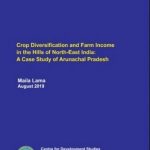 The working paper focuses on crop diversification and farm incomes in the hills of North East India. Crop diversification involves a shift of the resources particularly cultivated area from cereals and low value crops to high value crops like fruits and vegetables. The present study explores the status and extent of crop diversification in the hilly areas of the State of Arunachal Pradesh. The analysis of data reveals that productivity of different crops is lower in the State compared to the national average and that of other States. Hence emphasis should be on improving productivity on the one hand and on the other hand, focus should be on all income-generating activities like cash crops, floriculture, horticulture, fish culture and pig-rearing, agro-processing etc. to enhance the income of the farmers. The results showed that crop diversification had a positive and significant impact on farm income. Hence there is a need to introduce new technology, strengthen extension services, provide cheap credit, new inputs, marketing infrastructure and support prices. The cold storage facilities, irrigation and transportation should be improved for the development of the agriculture sector in the State.
The working paper focuses on crop diversification and farm incomes in the hills of North East India. Crop diversification involves a shift of the resources particularly cultivated area from cereals and low value crops to high value crops like fruits and vegetables. The present study explores the status and extent of crop diversification in the hilly areas of the State of Arunachal Pradesh. The analysis of data reveals that productivity of different crops is lower in the State compared to the national average and that of other States. Hence emphasis should be on improving productivity on the one hand and on the other hand, focus should be on all income-generating activities like cash crops, floriculture, horticulture, fish culture and pig-rearing, agro-processing etc. to enhance the income of the farmers. The results showed that crop diversification had a positive and significant impact on farm income. Hence there is a need to introduce new technology, strengthen extension services, provide cheap credit, new inputs, marketing infrastructure and support prices. The cold storage facilities, irrigation and transportation should be improved for the development of the agriculture sector in the State.
Dr. Anup K Das: “Rental Markets of Farm Capital Goods: A Study of its form, determinants of participation and impact on Agriculture”.
Working Paper No. CDS/03/2019
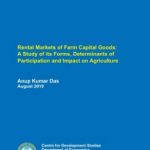 The working paper discusses the forms of rental markets, factors affecting the participation in such markets and its impact on agricultural production and productivity enhancing practices. Rental markets of agricultural machinery, especially which are expensive in nature, can play an important role in farm operation. It can facilitate farm mechanization even by small and marginal farmers for whom heavy machinery like tractor, power tiller etc. are not affordable. Rental markets of machinery can enhance farm mechanization further by increasing incentives to invest in such capital goods. In the presence of rental markets of farm machinery, owner farmers with insufficient land for fuller utilization of machine’s capacity can reduce the underutilization by renting-out the machinery. This adds to the return of owner farmers from their investment in such machinery. Rental markets of agricultural machinery can also be effective in helping farmers to cope with the changing circumstances, such as difficulty of rearing the draught animals due to lack of grazing land, frequent flood, man power shortage etc. The rental markets of farm machinery can contribute significantly to farm operations.
The working paper discusses the forms of rental markets, factors affecting the participation in such markets and its impact on agricultural production and productivity enhancing practices. Rental markets of agricultural machinery, especially which are expensive in nature, can play an important role in farm operation. It can facilitate farm mechanization even by small and marginal farmers for whom heavy machinery like tractor, power tiller etc. are not affordable. Rental markets of machinery can enhance farm mechanization further by increasing incentives to invest in such capital goods. In the presence of rental markets of farm machinery, owner farmers with insufficient land for fuller utilization of machine’s capacity can reduce the underutilization by renting-out the machinery. This adds to the return of owner farmers from their investment in such machinery. Rental markets of agricultural machinery can also be effective in helping farmers to cope with the changing circumstances, such as difficulty of rearing the draught animals due to lack of grazing land, frequent flood, man power shortage etc. The rental markets of farm machinery can contribute significantly to farm operations.
Dr. Prasenjit B Baruah: “Unorganised Enterprises and Financial Inclusion: A Study of Assam”. Working Paper No. CDS/04/2019
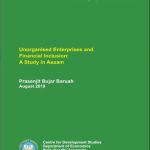 The working paper focuses on the status and patterns of financing of the unorganised enterprises of Assam. It also analyses the impact of financial access on the performance of the urban unorganised enterprises in the State. It indicates that a large number of unorganised enterprises are engaged in both manufacturing and services sector in Assam and have also employed a large percentage of the workforce in the State. The enterprises in this sector have contributed significantly to the gross state domestic product. Large percentage of the unorganised enterprises reported that non availability and costly credit were the main challenges faced by them and the own fund of the entrepreneurs was the main source of their investible resources and formed the maximum share in the total amount of working capital expenditure. To measure the depth of financial access an index was developed incorporating four aspects of financial access viz. saving, credit, insurance and payment through the financial institutions. Majority of the entrepreneurs have partial financial access and only a few have higher access to financial services. Thus, although financial coverage was not a major problem in the study area; depth of financial services was not found to be satisfactory.
The working paper focuses on the status and patterns of financing of the unorganised enterprises of Assam. It also analyses the impact of financial access on the performance of the urban unorganised enterprises in the State. It indicates that a large number of unorganised enterprises are engaged in both manufacturing and services sector in Assam and have also employed a large percentage of the workforce in the State. The enterprises in this sector have contributed significantly to the gross state domestic product. Large percentage of the unorganised enterprises reported that non availability and costly credit were the main challenges faced by them and the own fund of the entrepreneurs was the main source of their investible resources and formed the maximum share in the total amount of working capital expenditure. To measure the depth of financial access an index was developed incorporating four aspects of financial access viz. saving, credit, insurance and payment through the financial institutions. Majority of the entrepreneurs have partial financial access and only a few have higher access to financial services. Thus, although financial coverage was not a major problem in the study area; depth of financial services was not found to be satisfactory.
Prof. N C Roy: “Impact of Central Fund on the Economic Development of Arunachal Pradesh”. Working Paper No. CDS/05/2020
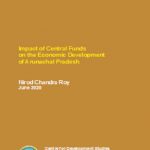 The working paper primarily highlights the processes that has resulted in the improvement in the quality of life of the people in the state, as an outcome of the overall economic development witnessed in recent times. The study attempts to quantify the role of the inflow of funds from the Centre to the State and its impact on the development process. Arunachal economy has witnessed a trajectory of growth which is well marked by its noticeable gradient. Unlike other states of the country the development programme in the state was launched only after independence. Till 1962, the year of Indo-China war, a gradualist approach towards development was undertaken. The war, drastically altered the vision of development towards the borderlands and the Government of India reoriented its policy to accelerate the growth of the Arunachal economy. This has resulted in the steady flow of funds from the Central Government to the State. The study is an attempt to quantify the effects of central funds upon the growth of income and other development indicators of the State.
The working paper primarily highlights the processes that has resulted in the improvement in the quality of life of the people in the state, as an outcome of the overall economic development witnessed in recent times. The study attempts to quantify the role of the inflow of funds from the Centre to the State and its impact on the development process. Arunachal economy has witnessed a trajectory of growth which is well marked by its noticeable gradient. Unlike other states of the country the development programme in the state was launched only after independence. Till 1962, the year of Indo-China war, a gradualist approach towards development was undertaken. The war, drastically altered the vision of development towards the borderlands and the Government of India reoriented its policy to accelerate the growth of the Arunachal economy. This has resulted in the steady flow of funds from the Central Government to the State. The study is an attempt to quantify the effects of central funds upon the growth of income and other development indicators of the State.
Prof. Amitava Mitra: “Challenges of Development in the Border Areas: An Empirical Study”. Working Paper No. CDS/06/2020
-
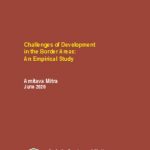 The working paper has explored the wide ranging inter-district disparities in the state of Arunachal Pradesh, in terms of availability of infrastructural facilities that are crucial for improving the economic condition of people in the state. The districts of the northern and eastern international border areas, with high mountains are less well serviced than the districts in the foothills of Arunachal Pradesh. Against this background, the study examines the developmental challenges, the socio-economic condition of the population at large, as well as the livelihood linkages in the international border areas of Arunachal Pradesh. All the border districts of Arunachal Pradesh and two border blocks (bordering with China) have been covered in the study. The identified challenges in the surveyed blocks include lack of physical connectivity, lack of educational facilities, lack of health facilities, erratic supply of electricity, almost no potable water supply, sanitation issues, frequent landslides, isolation and remoteness.
The working paper has explored the wide ranging inter-district disparities in the state of Arunachal Pradesh, in terms of availability of infrastructural facilities that are crucial for improving the economic condition of people in the state. The districts of the northern and eastern international border areas, with high mountains are less well serviced than the districts in the foothills of Arunachal Pradesh. Against this background, the study examines the developmental challenges, the socio-economic condition of the population at large, as well as the livelihood linkages in the international border areas of Arunachal Pradesh. All the border districts of Arunachal Pradesh and two border blocks (bordering with China) have been covered in the study. The identified challenges in the surveyed blocks include lack of physical connectivity, lack of educational facilities, lack of health facilities, erratic supply of electricity, almost no potable water supply, sanitation issues, frequent landslides, isolation and remoteness.
Prof. N.C. Roy, Prof. S. K. Nayak and Dr. D B Gurung: “Identification of the Potential Exportables of Arunachal Pradesh”.
Working Paper No. CDS/07/2020
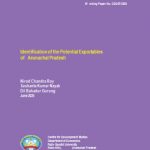 The working paper is a study on the export potentials of the state of Arunachal Pradesh. It emphasises on the fact that the resource endowments in the State are adequate for the expansion of outputs of a good range of commodities. There is a variety of horticultural products and indigenous orchids which can be produced commercially by overcoming the various challenges which the State faces in terms of infrastructural bottlenecks. However, the authors argue, that for this economic vision to be a reality, it is imperative that the producers get remunerative prices for their outputs.
The working paper is a study on the export potentials of the state of Arunachal Pradesh. It emphasises on the fact that the resource endowments in the State are adequate for the expansion of outputs of a good range of commodities. There is a variety of horticultural products and indigenous orchids which can be produced commercially by overcoming the various challenges which the State faces in terms of infrastructural bottlenecks. However, the authors argue, that for this economic vision to be a reality, it is imperative that the producers get remunerative prices for their outputs.
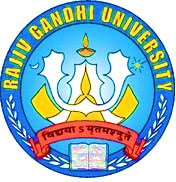

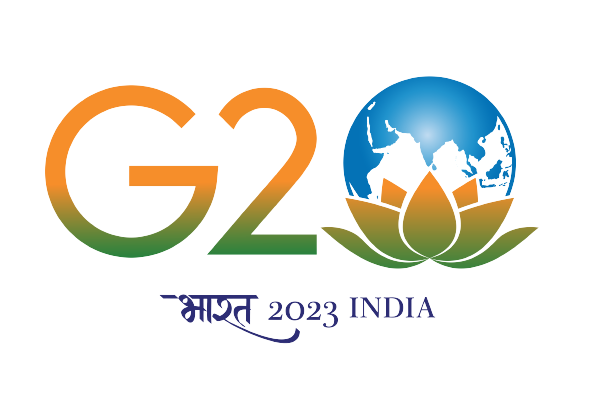
 The Vice-Chancellor, of Rajiv Gandhi University, Prof. Saket Kushwaha released a book and seven working papers in the Department of Economics. The book titled ‘Hill Economies and Sustainable Development-Emerging Realities’ and the working papers were released in a function held in the Department of Economics, RGU. Prof. Kushwaha appreciated and congratulated the Centre for Development Studies, Department of Economics, RGU and the authors for publishing their research output in the form of working papers. He, however, advised the department for wider publicity of the research output and dissemination of knowledge and to come out with a policy document by pooling of micro researches which can be used by the policy makers in formulating appropriate policy for the economic development of the State.
The Vice-Chancellor, of Rajiv Gandhi University, Prof. Saket Kushwaha released a book and seven working papers in the Department of Economics. The book titled ‘Hill Economies and Sustainable Development-Emerging Realities’ and the working papers were released in a function held in the Department of Economics, RGU. Prof. Kushwaha appreciated and congratulated the Centre for Development Studies, Department of Economics, RGU and the authors for publishing their research output in the form of working papers. He, however, advised the department for wider publicity of the research output and dissemination of knowledge and to come out with a policy document by pooling of micro researches which can be used by the policy makers in formulating appropriate policy for the economic development of the State. The Department of Economics has the distinction of acting as a nodal Department for the preparation of the First Human Development Report (HDR)of Arunachal Pradesh. The HDR project was coordinated by Prof. N.C. Roy and the other faculty members of the Department were actively engaged in the preparation of this report. It was a report which was based on primary survey conducted in around 5,257 households with 30,762 individuals covering all the districts of the State.
The Department of Economics has the distinction of acting as a nodal Department for the preparation of the First Human Development Report (HDR)of Arunachal Pradesh. The HDR project was coordinated by Prof. N.C. Roy and the other faculty members of the Department were actively engaged in the preparation of this report. It was a report which was based on primary survey conducted in around 5,257 households with 30,762 individuals covering all the districts of the State. The Department also has the distinction of preparing the First Arunachal Pradesh Development Report. The SDR project was coordinated by Prof. S.K. Nayak and with Prof. Atul Sarma, the then Vice Chancellor heading the Research Team. The faculty members of the Department were actively engaged in the preparation of SDR which was sponsored by the Planning Commission, Government of India, New Delhi.
The Department also has the distinction of preparing the First Arunachal Pradesh Development Report. The SDR project was coordinated by Prof. S.K. Nayak and with Prof. Atul Sarma, the then Vice Chancellor heading the Research Team. The faculty members of the Department were actively engaged in the preparation of SDR which was sponsored by the Planning Commission, Government of India, New Delhi. The book deals with issues and challenges of sustainable development in hill economies of India. It analyses the comparative advantages and challenges of the hill regions of India which comprises of 11 States.
The book deals with issues and challenges of sustainable development in hill economies of India. It analyses the comparative advantages and challenges of the hill regions of India which comprises of 11 States. This book has taken into account an in-depth analysis of urbanization, solid waste accumulation and management as well as household willingness to pay for improved solid waste management in selected towns of a state in the Eastern Himalayas, i.e., Arunachal Pradesh. The volume of municipal solid waste is increasing day by day because of increasing population, urbanisation, developmental activities, and changes in lifestyle, food habits and socio-economic activities etc., although collection efficiency and infrastructure are not growing adequately. Considering the advent of the Swachh Bharat Abhiyan Policy in India, this book can be an important document for academicians, environmentalists, environmental economists, professionals, social scientists, researchers, policy makers, planners, administrators, civic community and the general public concerned about urban environmental problems
This book has taken into account an in-depth analysis of urbanization, solid waste accumulation and management as well as household willingness to pay for improved solid waste management in selected towns of a state in the Eastern Himalayas, i.e., Arunachal Pradesh. The volume of municipal solid waste is increasing day by day because of increasing population, urbanisation, developmental activities, and changes in lifestyle, food habits and socio-economic activities etc., although collection efficiency and infrastructure are not growing adequately. Considering the advent of the Swachh Bharat Abhiyan Policy in India, this book can be an important document for academicians, environmentalists, environmental economists, professionals, social scientists, researchers, policy makers, planners, administrators, civic community and the general public concerned about urban environmental problems

 As the Indian economy integrates into global circuits of production, exchange and accumulation, the burdens of adjustment are shared unequally by different sectors, classes and regions. This study unravels the livelihood strategies and living conditions of labour in Assam’s tea sector, which has been undergoing a crisis since the 1990s. Stagnant production, decline in exports, and closures of many tea gardens have led to large-scale retrenchments in the labour force. The study begins by contextualising the Assam tea sector in a comparative and historical perspective and then delineates the chief employment characteristics of labour in this industry. Based on a detailed analysis of secondary data and primary field research, it goes on to examine the extent, types and implications of inter-generational occupational mobility (or immobility) among labourers in Assam’s tea gardens. In the process, it reflects on how even a sector that brought capital and labour from outside and contributed significantly to the country’s export earnings failed to create dynamic growth linkages within the local economy.
As the Indian economy integrates into global circuits of production, exchange and accumulation, the burdens of adjustment are shared unequally by different sectors, classes and regions. This study unravels the livelihood strategies and living conditions of labour in Assam’s tea sector, which has been undergoing a crisis since the 1990s. Stagnant production, decline in exports, and closures of many tea gardens have led to large-scale retrenchments in the labour force. The study begins by contextualising the Assam tea sector in a comparative and historical perspective and then delineates the chief employment characteristics of labour in this industry. Based on a detailed analysis of secondary data and primary field research, it goes on to examine the extent, types and implications of inter-generational occupational mobility (or immobility) among labourers in Assam’s tea gardens. In the process, it reflects on how even a sector that brought capital and labour from outside and contributed significantly to the country’s export earnings failed to create dynamic growth linkages within the local economy. The book attempts to understand household work, workforce participation, and division of labour in rural Arunachal Pradesh. Using both qualitative and quantitative approach, the average time spent on household work and agricultural activities by both men and women and the gendered division of labour has been examined by the author through a time use survey. In case of Arunachal Pradesh, the time use survey has an added significance, given the relative importance of subsistence production and low levels of commercialisation of the economy.
The book attempts to understand household work, workforce participation, and division of labour in rural Arunachal Pradesh. Using both qualitative and quantitative approach, the average time spent on household work and agricultural activities by both men and women and the gendered division of labour has been examined by the author through a time use survey. In case of Arunachal Pradesh, the time use survey has an added significance, given the relative importance of subsistence production and low levels of commercialisation of the economy. The Working paper focusses on the dynamics of Livelihoods along the foot hills of the State of Arunachal Pradesh. It deals with the various facets of livelihood activities and accesses. It ranges from occupational paradigm to land use pattern, from the household assets to farm practices, from dependence on natural resources to socio-institutional access. Based on the livelihood approach, the study has designed household livelihoods portfolio. It emphasis that the existing structures and processes do influence and shape the outcome of the livelihoods portfolio. The households in securing their livelihoods are faced with the problems of trading off and substitution of strategies and practices, giving rise to multiple least cost livelihood portfolios. In addition to farm activity, there are also set of allied farm activities in the portfolio of the households. The poor households are dependent upon
The Working paper focusses on the dynamics of Livelihoods along the foot hills of the State of Arunachal Pradesh. It deals with the various facets of livelihood activities and accesses. It ranges from occupational paradigm to land use pattern, from the household assets to farm practices, from dependence on natural resources to socio-institutional access. Based on the livelihood approach, the study has designed household livelihoods portfolio. It emphasis that the existing structures and processes do influence and shape the outcome of the livelihoods portfolio. The households in securing their livelihoods are faced with the problems of trading off and substitution of strategies and practices, giving rise to multiple least cost livelihood portfolios. In addition to farm activity, there are also set of allied farm activities in the portfolio of the households. The poor households are dependent upon The working paper focuses on crop diversification and farm incomes in the hills of North East India. Crop diversification involves a shift of the resources particularly cultivated area from cereals and low value crops to high value crops like fruits and vegetables. The present study explores the status and extent of crop diversification in the hilly areas of the State of Arunachal Pradesh. The analysis of data reveals that productivity of different crops is lower in the State compared to the national average and that of other States. Hence emphasis should be on improving productivity on the one hand and on the other hand, focus should be on all income-generating activities like cash crops, floriculture, horticulture, fish culture and pig-rearing, agro-processing etc. to enhance the income of the farmers. The results showed that crop diversification had a positive and significant impact on farm income. Hence there is a need to introduce new technology, strengthen extension services, provide cheap credit, new inputs, marketing infrastructure and support prices. The cold storage facilities, irrigation and transportation should be improved for the development of the agriculture sector in the State.
The working paper focuses on crop diversification and farm incomes in the hills of North East India. Crop diversification involves a shift of the resources particularly cultivated area from cereals and low value crops to high value crops like fruits and vegetables. The present study explores the status and extent of crop diversification in the hilly areas of the State of Arunachal Pradesh. The analysis of data reveals that productivity of different crops is lower in the State compared to the national average and that of other States. Hence emphasis should be on improving productivity on the one hand and on the other hand, focus should be on all income-generating activities like cash crops, floriculture, horticulture, fish culture and pig-rearing, agro-processing etc. to enhance the income of the farmers. The results showed that crop diversification had a positive and significant impact on farm income. Hence there is a need to introduce new technology, strengthen extension services, provide cheap credit, new inputs, marketing infrastructure and support prices. The cold storage facilities, irrigation and transportation should be improved for the development of the agriculture sector in the State. The working paper discusses the forms of rental markets, factors affecting the participation in such markets and its impact on agricultural production and productivity enhancing practices. Rental markets of agricultural machinery, especially which are expensive in nature, can play an important role in farm operation. It can facilitate farm mechanization even by small and marginal farmers for whom heavy machinery like tractor, power tiller etc. are not affordable. Rental markets of machinery can enhance farm mechanization further by increasing incentives to invest in such capital goods. In the presence of rental markets of farm machinery, owner farmers with insufficient land for fuller utilization of machine’s capacity can reduce the underutilization by renting-out the machinery. This adds to the return of owner farmers from their investment in such machinery. Rental markets of agricultural machinery can also be effective in helping farmers to cope with the changing circumstances, such as difficulty of rearing the draught animals due to lack of grazing land, frequent flood, man power shortage etc. The rental markets of farm machinery can contribute significantly to farm operations.
The working paper discusses the forms of rental markets, factors affecting the participation in such markets and its impact on agricultural production and productivity enhancing practices. Rental markets of agricultural machinery, especially which are expensive in nature, can play an important role in farm operation. It can facilitate farm mechanization even by small and marginal farmers for whom heavy machinery like tractor, power tiller etc. are not affordable. Rental markets of machinery can enhance farm mechanization further by increasing incentives to invest in such capital goods. In the presence of rental markets of farm machinery, owner farmers with insufficient land for fuller utilization of machine’s capacity can reduce the underutilization by renting-out the machinery. This adds to the return of owner farmers from their investment in such machinery. Rental markets of agricultural machinery can also be effective in helping farmers to cope with the changing circumstances, such as difficulty of rearing the draught animals due to lack of grazing land, frequent flood, man power shortage etc. The rental markets of farm machinery can contribute significantly to farm operations. The working paper focuses on the status and patterns of financing of the unorganised enterprises of Assam. It also analyses
The working paper focuses on the status and patterns of financing of the unorganised enterprises of Assam. It also analyses The working paper primarily highlights the processes that has resulted in the improvement in the quality of life of the people in the state, as an outcome of the overall economic development witnessed in recent times. The study attempts to quantify the role of the inflow of funds from the Centre to the State and its impact on the development process. Arunachal economy has witnessed a trajectory of growth which is well marked by its noticeable gradient. Unlike other states of the country the development programme in the state was launched only after independence. Till 1962, the year of Indo-China war, a gradualist approach towards development was undertaken. The war, drastically altered the vision of development towards the borderlands and the Government of India reoriented its policy to accelerate the growth of the Arunachal economy. This has resulted in the steady flow of funds from the Central Government to the State. The study is an attempt to quantify the effects of central funds upon the growth of income and other development indicators of the State.
The working paper primarily highlights the processes that has resulted in the improvement in the quality of life of the people in the state, as an outcome of the overall economic development witnessed in recent times. The study attempts to quantify the role of the inflow of funds from the Centre to the State and its impact on the development process. Arunachal economy has witnessed a trajectory of growth which is well marked by its noticeable gradient. Unlike other states of the country the development programme in the state was launched only after independence. Till 1962, the year of Indo-China war, a gradualist approach towards development was undertaken. The war, drastically altered the vision of development towards the borderlands and the Government of India reoriented its policy to accelerate the growth of the Arunachal economy. This has resulted in the steady flow of funds from the Central Government to the State. The study is an attempt to quantify the effects of central funds upon the growth of income and other development indicators of the State. The working paper has explored the wide ranging inter-district disparities in the state of Arunachal Pradesh, in terms of availability of infrastructural facilities that are crucial for improving the economic condition of people in the state. The districts of the northern and eastern international border areas, with high mountains are less well serviced than the districts in the foothills of Arunachal Pradesh.
The working paper has explored the wide ranging inter-district disparities in the state of Arunachal Pradesh, in terms of availability of infrastructural facilities that are crucial for improving the economic condition of people in the state. The districts of the northern and eastern international border areas, with high mountains are less well serviced than the districts in the foothills of Arunachal Pradesh. The working paper is a study on the export potentials of the state of Arunachal Pradesh. It emphasises on the fact that the resource endowments in the State are adequate for the expansion of outputs of a good range of commodities. There is a variety of horticultural products and indigenous orchids which can be produced commercially by overcoming the various challenges which the State faces in terms of infrastructural bottlenecks. However, the authors argue, that for this economic vision to be a reality, it is imperative that the producers get remunerative prices for their outputs.
The working paper is a study on the export potentials of the state of Arunachal Pradesh. It emphasises on the fact that the resource endowments in the State are adequate for the expansion of outputs of a good range of commodities. There is a variety of horticultural products and indigenous orchids which can be produced commercially by overcoming the various challenges which the State faces in terms of infrastructural bottlenecks. However, the authors argue, that for this economic vision to be a reality, it is imperative that the producers get remunerative prices for their outputs.